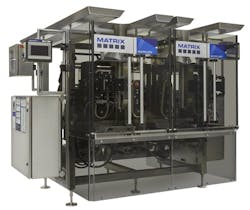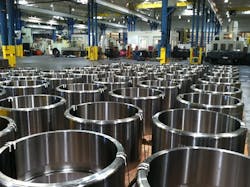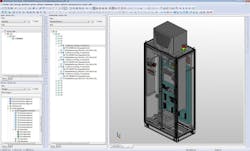Dave Perkon is technical editor for Control Design. He has engineered and managed automation projects for Fortune500 companies in the medical, automotive, semiconductor, defense and solar industries.
When building machines, integrating systems or supplying equipment, there is often a multidiscipline team of mechanical engineers, control designers, programmers, electricians and machine-build technicians working on the project. Keeping information and requirements current and correct and the project moving to completion is important to the bottom line.
This view into machine builder and vendor internal processes shows how their business is run and how the design teams interact along with software, project management and document control methods. In these design and manufacturing phases of the project, there is much experience that both the OEM and vendor can bring to the table.
While some have made no profound innovations, others have created custom ERP systems and developed extensive project management procedures, but all use a mix of tried and true techniques.
On the same page
OEMs and equipment vendors employ a wide variety of techniques, tools and software to keep the flow of information moving between mechanical design, control design and manufacturing in a timely, understandable and accurate format. "It’s all about the process," notes Matt Wicks, vice president, manufacturing systems at Intelligrated in St. Louis, Missouri. Ensuring the respective groups adhere to the process is critical to the development of complex solutions and projects (Figure 1).
Figure 1: The creation and meetings of multidiscipline teams keep the flow of information moving between mechanical design, control design and manufacturing.
Source: Intelligrated
There are software tools such as SharePoint, MS Project, SolidWorks Vault and features within Oracle that help to facilitate and streamline the process. Depending on the size and scale of the projects, “stand-up meetings” are a simple and effective means to keep the flow of information moving.
Pulling the team together for brief communications meetings to ensure all groups are talking can yield effective results. Wicks says he’s surprised by what comes out of some of his stand-up meetings. The key is to create an environment that facilitates a good flow of information so that people are allowed to share what’s on their minds.
Compass Automation in Elgin, Illinois, uses a mix of tried-and-true techniques such as stand-up meetings and visual management. "We also use newer technology, including a custom ERP system written in-house," notes Project Managers Phil Rogoz at Compass Automation.
Figure 2: Old-fashioned email, Excel, MS Project and weekly production meetings get the equipment designed and built at Matrix Packaging Machinery.
Source: Matrix Packaging Machinery
Matrix Packaging Machinery in Saukville, Wisconsin, uses good old-fashioned email, Excel, MS Project and weekly production meetings. "It gets the job done," notes Marc P. Willden, general manage at Matrix Packaging Machinery (Figure 2).
Size does matter
Troy Miesse, head of North America System Consulting at Rittal, mirrors much of the machine builders' comments. "The size and complexity of the machine builder’s or system integrator’s organization will dictate how information flows between different groups," he says. “Although there’s not one way to handle this process, every business has to get it right because the company’s very existence depends on it. For smaller firms, information can be communicated via a simple Excel spreadsheet, a hardcopy checklist, an e-mail or a face-to-face conversation."
Also read: How to build an automation team
For larger firms and projects, more people and locations are typically involved, requiring the introduction of many other techniques and tools. "For example, project tracking/management software such as Microsoft Project can be helpful in determining the overall scope and schedule of a project," notes Miesse. "A product specification helps to guide the development/engineering of a product. Computer databases and product libraries are used to store and develop information and documentation."
A manufacturing execution system (MES) can help plan and execute specific job and applications such as computer aided drawing (CAD), computer aided manufacturing (CAM) and computer aided engineering (CAE) and can also provide the needed details with drawings/models, BOMs, assembly drawings and software listings, continues Miesse. "The largest companies with multiple product lines and projects will use the MES to manage project efficiencies and enterprise resource planning (ERP) to manage all the projects from start to finish," he says.
Built-in problems
Equipment vendors work with a variety of machine builders and can provide interesting insight into problems with multidiscipline teams. Among the machine builders that National Instruments serve, it sees a wide range of tools and techniques used to manage the flow of information across groups and stages of the project lifecycle—from heavyweight PLM software on one end of the spectrum to heroic word processing on the other and everything in between.
"The reality of the problem is that a varied and disparate set of tools are used between mechanical design, control design and manufacturing; and, interestingly, this disparity has been accidentally created," states Anna Kozminski, senior software manager, embedded system design, at National Instruments. "These processes all have different histories and the tools used in each were purpose-built and not designed to cooperate cross-functionally."
For example, there are many differences between version control tools used for software and hardware. "Mechanical designers typically use CAD tools, and software designers choose from a huge range of free and open source software," continues Kozminski. While National Instruments’ LabView provides software development tools that unify with source code control, other software and design packages may not.
Not only are there software and hardware disparities, personnel differences and conflicting priorities are also present. "Management works hard to avoid a CYA atmosphere, but at times the attitude that one department is taking care of the mess of another department can prevail,” notes Compass Automation’s Rogoz. "We are making progress on this issue through cross-training our engineering staff and encouraging engineers to spend more time on the shop floor."
Another major issue is conflicting priorities, comments Rogoz. "We think of our company as lean and agile, but that can lead to employees having more than one boss," he comments. "To counter this, an established yet fluid list of project priorities prevents the strongest personality from always prevailing in resource allocation disputes."
Even with the priorities known, thinking outside the box is important. "It can be a problem getting everyone to think about other disciplines beyond their own," states Intelligrated’s Wicks. "Mechanical engineers generally think specially, ‘Does it fit? Are there interferences?’ Controls and software engineers tend to think about processes. What is the sequence of operations? What about when something doesn’t happen as expected?"
Ignoring an issue because "it’s not my discipline" or hiding in the corner to do your work can be a problem. "It’s critical with a multidiscipline team that the mechanical designers think through the controls and software challenges and vice versa, so they can most effectively solve the problem, be that mechanically or with software and controls," notes Wicks.
Coordination problems occur when transparency and follow-up between teams lack or start to dissolve, comments Chris Noble, district sales manager, Aventics. "The process should be a closed-loop system, not an open-loop system," he said. "The biggest attributes to this can be too much reliance on email communication and the lack of details up front. This doesn’t mean we need more meetings; it simply means people need to pick up the phone or have a quick face-to-face with team members at the beginning and during the course of a project, especially if dates are slipping or the cost of something spikes unexpectedly. Top project mangers with strong communication and organizational skills can be the key to keeping transparency and follow-up a top priority between teams."
The toolsets don’t promote cross-domain collaboration, not just in terms of information sharing and requirements tracking. More crucially this prevents traceability from requirements to implementation when spanning multidiscipline teams, notes National Instruments’ Kozminski. "This makes it very difficult to predict how a change made by one team will affect the others,” says Kozminski. “What will the consequences be, and what problems will this change create? Traceability of dependencies across multidiscipline teams is a manual and error-prone process, and the ripple effect of changes from one team can cause major timeline or product quality consequences down the road, which could not have been easily forecast."
Most teams have differing priorities; managing and aligning these is often difficult to do, comments Jefferson Myers, manager of software products for Leggett & Platt Smart Products. "We believe that communications and giving all teams visibility to a project and sharing deadlines is critical to a positive team atmosphere and actually getting everything done and meeting goals for success," he says.
Communicate more
Communication is at the heart of successful multidiscipline teams. Cooperation and leadership are also an important piece of effective teams.
"The biggest tool for multidiscipline teams is communication," notes Matt Carpenter, director of engineering, North America at B&R Industrial Automation. "It's essential that project roles are clearly defined and that responsible parties collaborate on planning and progress throughout the project. Each group needs to develop a plan, in detail, where activities can be tracked and monitored and where plan updates can be made. Keeping everyone in sync helps to avoid last-minute surprises when certain activities fall behind or run into complications."
Managing a multidiscipline team during product development can often be like a coach trying to win a football game, states Bill Dinham, application software engineer at Beckhoff Automation. "Critical elements such as communication, cooperation and leadership are integral to the success of the team," he says. "Regardless of how talented any individual is, all team members must communicate assignments and call out information as the situation on the field, or in the office, changes. Of course, there must be a leader who provides guidance and motivation to hold everyone on the team together in the pursuit of victory."
It cannot be overstated that the best strategy to keep projects on track is direct communication, continues Dinham. "Mechanical and controls engineers need to discuss actuators and sensors," he states. "Mechanical engineers and plant floor personnel need to discuss door openings and how to install the equipment. Each functional area must maintain high levels of transparent communication to assure that the team can effectively work together in order to complete projects in an efficient and expedited manner. This has a direct and hugely positive impact on time to market."
As a way to facilitate constant, proactive communication, emails and Internet meetings are invaluable when team members are far apart. However, these tools are not without their shortcomings, as with any type of communication. "Decisions reached by a subset of the project team need to be communicated to the whole team, and people under time or technical pressure may not bother to send a simple email or write up meeting minutes," notes Dinham.
Figure 3: Careful planning of engineering and manufacturing produces a quality product.
Source: Itamco
It is difficult dealing with multiple departments in several facilities, says Joel Neidig, business development & technology manager at Indiana Technology and Manufacturing Companies (ITAMCO), a multidiscipline gear shop in Plymouth, Indiana. "We still have an advanced product quality planning (APQP) kick-off meeting for each new job with all the stakeholders in the organization to see it through from start to finish," he comments. "We examine all the risks and pitfalls before the start of the project, so we can be prepared. Each team is assigned tasks with due dates. There is a champion for each task, as assigned by the APQP administrator, responsible for completing the task (Figure 3)."
Coordinating projects that can range from regional to global poses a wide variety of challenges, says Sean O’Grady, product manager, valve terminals and electronics, Festo. "Simply managing communication among players in multiple time zones is challenging. The unified nature of our ERP and ISO procedures helps to streamline these potential headaches."
Location, location, location
Dealing with multidisciplinary teams is common within the automation space. Batch, drives, safety, motion, visualization and information teams often must tightly collaborate to ensure project success.
"A significant challenge with coordinating multidisciplinary teams today is location and connectivity," notes Bryan Siafakas, Studio 5000 software product manager at Rockwell Automation. "Teams are typically geographically dispersed and do not have the luxury of being connected and working at the same time. Bringing these disciplines together into an integrated development environment such as the Rockwell Software Studio 5000 design environment helps to increase efficiency and drive automation productivity. Rockwell Automation understands these real-world situations and offers solutions, like a code compare-and-merge tool, to mitigate the risks of collaborative engineering."
Another challenge in coordinating teams occurs during commissioning, continues Siafakas. These teams must come together on a running system to make online edits. By using a single platform, multiple users can easily connect to the running system and manually modify the code or utilize the partial import online (PIO) feature. The ability to add or modify code without affecting a machine’s OEE is a huge value to users.
Team interface
Engineering interfacing with manufacturing is an area you can't lose sight of. Often, engineering teams are so focused on the goal of completing the machine and controls that requirements for manufacturing are an afterthought.
"Our engineers consider the manufacturing teams as machine users and define control requirements from their perspective," states B&R’s Carpenter. "For example, how does the manufacturing team perform settings, calibrations, or initial test runs? By defining this, we can make sure the software meets the needs of both internal and external customers."
The result of this can be simple step-by-step instructions to build and configure machines or more advanced processes like configuration tools that guide technicians through the steps to automatically select the parameters and settings needed for a specific machine under construction.
"For a plant-wide multidiscipline team, engineering primarily communicates with manufacturing and build through our ERP system,” notes Rogoz at Compass Automation. "This is supplemented through individual interaction; for example, our employee in charge of machining vendors spends part of his day in the office with our mechanical engineers, lowering the barrier to communication that normally exists when he is on our shop floor and the engineers are in their workplaces.”
The interfacing between engineering and manufacturing should happen very early in the design phase. "The earlier those in manufacturing are engaged by engineering, the more impact they can have on improving the design for manufacturability, comments Wicks at Intelligrated. "There is a point that is too early, which results in having too many cooks in the kitchen, so it’s a balance to let the engineers design as required while pulling in the manufacturing/build teams for their feedback."
From day one of any new build and as common practice, needs and expectations from engineering to manufacturing/build need to be communicated clearly, notes Noble at Aventics. "You need to begin with the end in mind,” he says. “With the mindset of a closed-loop system, output needs input. Using the keep-it-simple-stupid (KISS) method, engineers can make rounds at specific times of the day or week to check on progress or problems. This can prevent engineers from becoming inefficient and help minimize distractions and mistakes."
Change is a big word
Project management plays a critical role in any project or product development process, states Wicks at Intelligrated. "They function as the backbone of the team, providing clear direction on scope and schedule," he says. "It’s their responsibility to keep their project/product development teams well-informed about the schedule, scope and changes."
How a project manager (PM) chooses to notify the team is up to the individual PM, whether through email, text, verbal communication or automatic notifications. The critical part is that the communication happens and that the PM ensures that it does.
Similar methods are used at Compass Automation. "Managers hold a weekly project review, where schedules, requirements and changes are discussed,” comments Rogoz. "Each manager has leeway in how to communicate that information to his or her team. Some provide the information visually in a daily standup or simply by email."
Obviously, each organization will handle this somewhat differently; smaller firms often just notify each discipline via email or a simple phone call, but many companies employ traditional methods such as engineering change notices (ECNs), deviation requests or work change notices and design change request forms, says Miesse at Rittal
Figure 4: Software environments allow information to be conveyed quickly, accurately and timely.
Source: Rittal
"Companies that employ an ERP system can track changes and notify the appropriate people in real time. The ePlan environment can help to coordinate disseminating information to the people and systems involved in a timely manner," he states (Figure 4).
The future may simplify change notification. "The smart machine-build companies will try to make as much information cloud-based as possible," notes Noble at Aventics. "Change and other notifications can be posted there, and alarms for slipping dates or budgets can be set. Accessibility to Gantt charts as an example can make it easy for teams to check progress instantly and efficiently, even from their smart phones, avoiding unnecessary phone calls or emails."
Bring teams together
A variety of software tools are available for multidiscipline teams and companies. At Compass Automation, engineering, purchasing, manufacturing and programming are all tied together in its ERP system. After an engineer designs a part, he will enter the part into the ERP system as ready for manufacturing. The engineer’s manager approves the part for purchasing, triggering automatic notification of a purchasing team member that a part is ready to be bought. The purchaser can then generate a PO automatically and engage with the correct vendor. Shipping, receiving and operations can check the ERP system for part delivery dates. Part status is updated throughout the process, so PMs can update customers and make any necessary changes to the project schedule.
"Unfortunately, there isn't a silver-bullet technique or software package that can handle the complexity and uncertainty of manufacturing," comments Neidig at ITAMCO. "But, we use a combination of Autodesk Vault, Autodesk Product Design Suite, Microsoft Dynamics GP ERP system, QUPID, which is a homegrown quality management system, Microsoft SharePoint with custom workflows, Microsoft CRM and email.”
A bidirectional data exchange streamlines collaboration between engineering and manufacturing, notes Siafakas at Rockwell Automation. "By automating this exchange, designers can easily exchange electrical CAD data, such as I/O names and assignments, in an error-free manner," he says. "This helps to ensure panel builders have accurate information, which can help reduce overall defect costs. For example, Rockwell Automation supports bidirectional data exchange with its Encompass Partner e-Plan to keep the design and build process synchronized."
For many Rittal and ePlan customers, the ePlan computer aided engineering (CAE) environment is central to conveying information quickly and accurately and updating it in a timely way. It supports entering and updating BOMs, schematics and drawings/models and allows tracking changes throughout the design process. It helps to manage the data between design, purchasing and manufacturing with automatic updates.
"Leggett & Platt’s Curo software enables companies to track data on the factory floor and have it shared with the appropriate associates company-wide," states Myers at Leggett & Platt Smart Products. "This proprietary software system allows continual monitoring of all day-to-day activities including job and billing management, day-to-day time entries, project tracking, project status and updates, just to name a few. The system tracks the percentage of completion."
One of our goals at Rockwell Automation is to make a seamless transition from different project phases, notes Siafakas. "A seamless transition increases a project’s efficiency and reduces costly overruns." Rockwell's Integrated Architecture Builder (IAB) is a sizing and selection tool for efficient quoting. Users can then import that data into the Rockwell Software Studio 5000 Architect software to continue the layout and configuration process. Once configured, users can create controller and HMI projects with a single click.
Other vendors use software tools to tie together design tasks. "We employ the Festo suite of design, calculation and commissioning tools for specialized calculations or to streamline common design tasks,” states O'Grady. "Festo has invested a great deal into integration projects that link manufacturing, logistics and planning systems. Engineers and managers throughout the organization have access to tools that help to plan material, process, manpower and equipment. These systems also benefit the financial planning and transparency of the organization."
Connecting teams
One thing is clear, whether a machine builder or vendor, many multidiscipline techniques are commonly used, but others are custom. In either case, engineers and manufacturing are tied together, and, whether at their desks or on the shop floor, a computer is involved—they are on their desks and all over the shop floor.
With a solid network and computer, software tools are many and continue to grow, as will the dashboard, workflow, analytical and communication tools. Whether a document, spreadsheet, MES or ERP system, they will integrate the multidiscipline teams together, and, with the continued emergence of the cloud, engineering and manufacturing will be able to help complete the work from anywhere.










